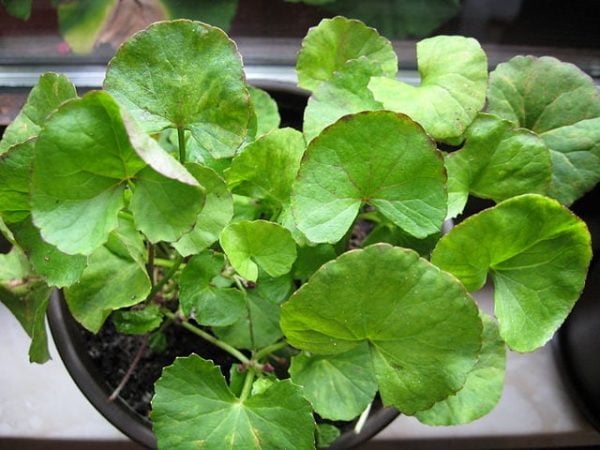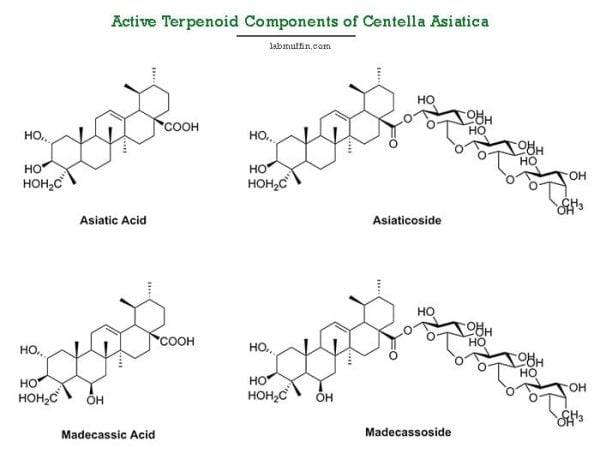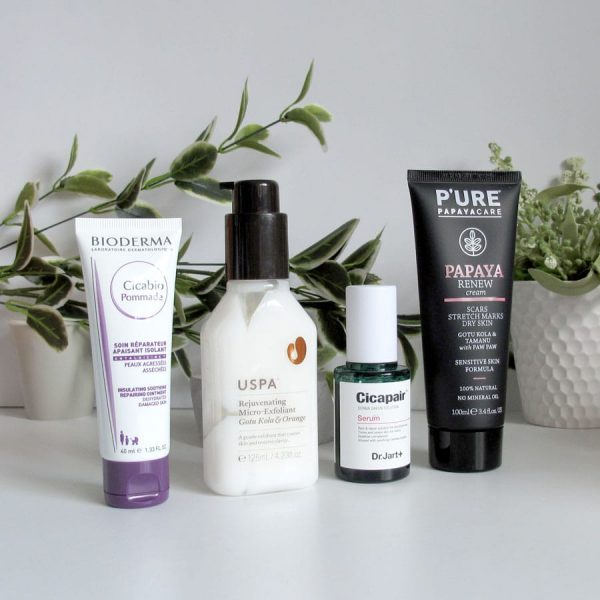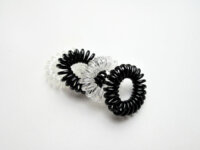Centella asiatica’s been in skincare for a long time, but it’s really getting its time in the spotlight at the moment. What is it and what does it do? Here’s the science behind this trendy botanical ingredient.
What is Centella asiatica?
Centella asiatica, also known as Gotu Kola and Indian pennywort, is a herb that’s been traditionally used in Indian Ayurvedic medicine. In some Asian countries the leaves are used in salads and drinks. It looks like this:

What’s in Centella?
Centella asiatica contains a bunch of active ingredients known as terpenoids, which make up around 8% of the weight of the plant. The main four that have been studied for their skincare benefits are asiatic acid, madecassic acid, asiaticoside and madecassoside. They’re sometimes included in a product alone in pure form, or in combination as “Centella asiatica extract”. The terpenoids have very similar activities.

Along with the terpenoids, there are also other components that have skincare benefits: antioxidants, humectant moisturisers and vitamins.
What does Centella do?
Centella is most famous for its healing properties – a lot of Centella products contain the prefix “cica-” which, as a lot of astute readers have informed me, refers to its cicatrising or healing/scar-forming abilities.
Most of the published studies are in vitro or animal studies – there’s a nice summary here. The few clinical trials on Centella and its components are quite annoying as well, because it’s frequently combined with other ingredients so you can’t tell if it’s Centella or the other ingredients doing the majority of the work.
- The only decent clinical trial using Centella skincare on humans is a small trial which found that an asiaticoside-containing cream improved crow’s feet, compared with a cream that didn’t contain asiaticoside.
- There have been lots of studies on wound healing in rats: both Centella asiatica extract and asiaticoside helped heal rat wounds. Centella asiatica extract seems to help healing by speeding up skin cell production and collagen synthesis. It’s also antibacterial, and may increase antioxidant activity and blood vessel formation.
- Madecassoside could prevent hypertrophic scar and keloid formation according to an in vitro study, while asiaticoside helped hypertrophic scars in a rabbit ear model.
- Madecassoside prevented UV-induced hyperpigmentation (tanning) in excised human skin in vitro.
- There are a few studies on oral Centella extracts where it healed wounds faster and reduced vein issues during flights, but they aren’t really that relevant when we’re talking about skincare products.
Overview of some Centella skincare products

I’ve tried a few Centella products lately. I’ve also been using La Roche-Posay Cicaplast for quite a while for healing inflamed skin like in my chapped nose routine, even before I realised that the magic ingredient was Centella! Specifically, Cicaplast contains madecassoside as its Centella active, along with copper, zinc, manganese, and a whole bunch of moisturising ingredients to help speed up healing.
My current favourite Centella product has been Bioderma Cicabio, which contains Centella-derived asiaticoside, asiatic acid and madecassic acid alongside resveratrol and copper to promote healing and zinc to control bacteria. Cicabio also contains Bioderma’s patented Antalgicine, which reduces itching (I think it’s some combination of Laminaria ochroleuca extract and acetyl dipeptide-1 cetyl ester). I’ve tried both the Pommade and the Creme. The Pommade has a much stickier ointment texture, while the Creme sinks in much more easily. I used the Pommade on a skin rip I got from Crossfit, and found that it was fantastic at sticking in place.
Uspa Rejuvenating Micro-Exfoliant is a leave-on exfoliating product that contains Centella asiatica extract, along with salicylic acid and a bunch of other botanicals. I’ve only used this a couple of times so I haven’t seen any exciting results yet, but it has a nice texture.
Dr Jart’s Cicapair range includes a serum, and three creams (Re-Cover, Re.Pair and one that’s just a Cream). They all contain Centella asiatica extract alongside the four terpenoids (asiaticoside, asiatic acid, madecassic acid and madecassoside) added separately as well. The ingredients lists are pretty long and they contain other beneficial ingredients as well like niacinamide. I’ve tried all four products. They’re really nicely soothing and the green tint neutralises redness on your face nicely, although I’ve found that I haven’t really used them in the day because they seem to be better tailored to dry skin.
Pure Papaya Renew is a new product from Pure Papaya Care. It’s a cream that’s meant to reduce the appearance of scars, stretch marks and dry skin, with Centella asiatica, tamanu oil and papaya as its key ingredients. The cream smells really nicely of vanilla, and has a lovely texture that’s not too heavy. While the product seems pretty good, I’m not a fan of the marketing, which is a bit pseudosciencey (“60% of what you put on your skin is absorbed into the bloodstream”, anti-mineral oil, “100% natural”).
Have you tried Centella products? What were your favourites?
Products were provided for editorial consideration, which did not affect my opinion. This post also contains affiliate links – if you decide to click through and support Lab Muffin financially (at no extra cost to you), thank you! For more information, see Disclosure Policy.






Not knowingly, but I think I had a cream once that used it as ingredient. Now that I know more I can look out for it and see if it does anything for me.
Good luck! It’s such a favourite right now 🙂
Kosmea Rose Glow Body Mist contains Centella Asiatica. It is second on the list of ingredients. I bought the body mist to use with Kosmea Rose Glow Body Oil because the oil did not seem to be absorbing into my skin. I think that the oil has an ingredient that makes it a dry oil (isoamyl laurate). I ended up using the body mist as a facial mist, and it is lovely for this purpose.
That sounds really nice! I haven’t used Kosmea in a while actually, nice to see that their range is expanding!
oh gosh I saw this ingredient on a serum I bought recently! iUNIK actually puts Centella Asiatica Leaf WATER in their tea tree serum and their black snail serum. I use the former only as a spot treatment and started using the latter when I had a rash on my face – they both worked like magic!
That’s fantastic! 😀
I’ve been curious about the Dr.Jart collection, but I just don’t want to fork over the money for it. Goodness, $70 and up. Maybe I’ll try La Roche instead. I want something that calms my weird redness and irritation on my chin.
Give it a go! You can also try looking at some other Asian beauty brands – if you buy online they can be very affordable 🙂
Re: I want something that calms my weird redness and irritation on my chin.
If you do find something let us know. I have the same and it drives me nuts.
Hi Michelle, I wonder if cicaplast would work when paired with retinol to prevent flaking. That would be a type of repair wouldn’t it? Not sure.
Also, do you have the line Avene in Australia? They have a product very similar to LRP cicaplast. It’s called Cicalfate restorative cream. It works really well on dry chapped hands.
It would definitely help! We do have Avene but I haven’t seen that product before 🙂
The W.Lab Centellaca ampoule was popular in here (Korea) last year or so. It’s a powerhouse with centella water, centella extract, and all the 4 centelloid compounds. It was really interesting to me since it’s a serum rather than a cica-cream, which tends to be too much on my acne. But, starting this summer the “skincare diet” trend evolved to the “cica skincare” trend and people are using cica products like crazy. Some brands are coming out with entire lines centered on toner, serum, cream, sunscreen, even makeup using centella extracts and compounds. So it’s not hard to find a product that works on your routine anymore, and i find it interesting to be able to hydrate/moisturize your skin while still getting cica treatment rather than needing to have one extra step for that.
It’s been so handy! I think they should do that with a lot of other beneficial and low risk ingredients… like niacinamide 🙂
What a great ingredient! I found PURITO Centella Green Level Recovery Cream on Amazon. It contains 50% of tiger grass. Have you tried it yet?
Oops I mean 50% centella asiatica.
I am also curious about Purito products containing centella asiatica.
I use the purito cream over my skin when it is irritated and also in conjunction with my Retin-A it works amazing! If I have any irritation or redness on my skin one application of that and it’s gone. Also I love that that brand’s cream has an extremely high concentration of centella and it’s inexpensive and easily available on Amazon for a large tube. I find that most brands with Korean beauty ingredients that are marketed to Americans are super expensive but when you go and find the Korean skin care lines that aren’t popular here, you actually get much better ingredients and product for a much lower price and there’s quite a few websites that specialize in Korean skin care so they’re not actually hard to obtain.
Hi Michelle! I have this plant growing in my backyard out of nowhere (I live in Indonesia where it’s common). What can I do to use it as a skincare?
I love how thorough your approach is to researching Centella Asiatica. In some of the studies I saw online, Centella Asiatica seemed to correlate with a decrease in the fertility of the male rats in the study. While the ingredient was taken orally, and this wasn’t tested on humans, wondering if you stumbled upon this in your research and as a female if it should be cause for concern?
I haven’t seen this – I don’t think it’s worth worrying about for skincare use. Centella is used in food in some places and there aren’t any reports of hormonal disturbances, so the dosage in cosmetics would be much much weaker!
I use the Missha Time Revolution First Essence 5x. It contains 97% CICA yeast ferment. The other probiotic it contains is bifida ferment lysate.
Aside from the humectants, it contains niacinamide. Certainly I expected it to be hydrating. But I have to admit I was pretty surprised at its healing powers.
I had used another product on my neck and chest that caused pretty severe contact dermatitis. Dermatologist couldn’t see me for a couple of days. My neck was particularly effected. Out of desperation I applied the Mischa essence on my neck.
The skin had been so dry and tight it looked crinkled. It stung when I moved my neck. When I applied the Missha essence it was instant relief. Skin softened and released. The stinging went away. The color started to come back. I applied the essence a few times throughout the day.
The next morning my skin had begun to peel. So I knew I was healing. The skin underneath looked clear and healthy. Nothing was stinging. The new skin did not look wrinkled or tight.
I’ve since added Missha’s Night Repair Extreme Ampoule. It’s full of the bifida ferment lysate and other probiotics. There’s some things in there that or frivolous that I’d rather not have in there.
Between the Missha Essence and Night and Repair my skin has it looked this good in several years. Dark spots are fading. My color is brighter. My pores are smaller. Skin is softer. My skin is plumper. My skin is very soft. My skin is smoother. I can’t believe how much better it looks. I have a prescription for tretinoin that I just started. But I’m really wondering if I need it.
Water, Glycerin, Propanediol, 1,2-Hexanediol, Niacinamide, Yeast Ferment Extract, Diethoxyethyl Succinate, Bifida Ferment Lysate, Sodium PCA, Butylene Glycol, Ethylhexylglycerin, Adenosine, Xanthan Gum, Ceramide NP, Hydrogenated Lecithin
I had big big hopes in this ingredient. Bought Skin1004 Madagascar Centella serum, and it calmed down my redness, but after second use, it broke me out horribly – first red dots on my cheeks, followed by tiny whiteheads. They also appeared on my nose, under it, between brows, but without the initial red ones. And one cystic spot on my temple.
Once I stopped using it, they disappeared after 2 days, but the cystic one is still there.
I thought maybe it’s because of Butylene Glycol, but I started googling about Centella breaking peoeple out, and Reddit threads were pretty big with people reporting the same thing as me – mostly the same product, but some people reacted even to other products, including Cicaplast.
Any ideas what’s wrong and why?
Here are ingredients:
Water, Glycerin, Butylene Glycol, Centella Asiatica Extract, 1,2-Hexanediol, Cellulose Gum, Ethylhexylglycerin
I also used it AM with Azelaic acid:
Aqua, Propylene Glycol, Azelaic Acid, Dimethicone, Carbomer, Lecithin, Sodium Hydroxide, Disodium EDTA
Maybe they clashed together? The Azelaic acid product is liposomic.